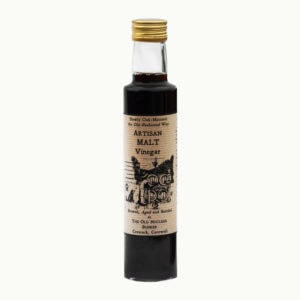Malt vinegars have become linked–if not exclusively, primarily–to fish-and-chips over the years. And it’s true: a dash, or a douse, if you prefer, is an essential and delicious enhancement to fish-and-chips. However, the times, they are a’ changin’ for malt vinegars.
And a good, artisanal malt vinegar like Artisan Malt Vinegar? Winner of Taste of the West Gold for 2016-2019 and the Great Taste Award Gold? Well, the options are limitless!
After hearing recipe ideas from founder of Artisan Vinegar Company (under Tremayne Food and Drink Limited), Mark Nattrass, as well as renowned chefs–and a not-so-renowned chef (that’s me!)–you will undoubtedly be ready to crack open the endless possibilities of this malt vinegar.
So a bit of the nuts and bolts.
Artisan Malt Vinegar Company is a part of Artisan Vinegar Company in Cornwall, UK in an old nuclear bunker in the scenic village of Coverack. First, in 2004, came Lizard Ales–a production of bottle-conditioned ales. Next, came Artisan Malt Vinegar production. It is made in small batches, live, unpasteurized, slow-fermented and oak matured in barrels for a mellow, rich acidity. And there’s a third project in the works–Tremayne Winery. The plants are in the ground: keep your eyes open for those bottles! Soon enough. Tremayne was founded by Mark, his wife Lenora, and their friend, Richard.
And now today, as Mark puts it, “Richard has gone off to the great saloon-bar in the sky. And Leonora now spends her time writing novels. But I’m still here–plugging away.”

What’s special about Artisanal Malt Vinegar? Aren’t all vinegars bringing the same thing to the table: acidity? Couldn’t you use sherry vinegar in place of malt vinegar and vice versa. Well, yes and no.
Marks says, “In some ways, our product is similar to a good sherry or balsamic–and it can be put to a lot of the same uses. But there are differences. Wine, sherry and balsamic vinegars tend to come from a stronger alcohol base–so they tend to end up having a higher acid content.” Typically in the range of 6-7%.
He goes on to explain that he does not specify an acid percentage for his Artisanal Malt Vinegar because of the inherent variation due to the natural process. Plus, there is no dilution to get a set acid percentage; however, the acid generally falls around 5%. The flavor profile lies not just in less acidity but in the base of the malt vinegar. Most other vinegars have a fruit base while malt vinegar is made from malted barley. And there are lots of different types of malt. Mark says, “Some taste as you would expect a malt to to taste–malty! But others are roasted to produce toffee or caramel flavours, or coffee and dark chocolate. We use a mixture of malts to try to bring through those flavours–to balance the acid with those sweet and bitter notes. Then Artisan Malt Vinegar is oak-matured (for about a year), and the oak adds another layer to the flavour.”
The result? A malt vinegar with a mellow acidity and mouth-filling rounded flavor.

And what do professionals have to say about the flavor? Michelin-starred chef Josh Eggleton of England’s Salt and Malt (a fish-and-chip shop with 2 locations), Pony and Trap (a pub), and Yurt Lush (a cafe and bar in, yes, a yurt!) says, “Artisan Malt vinegar is delicious. It’s got a brilliant depth of flavor that you just don’t find elsewhere. We use it across all our restaurants…to make and finish a wide range of sauces, dressings, marinades and preserving liquors and chutneys. We also serve it with our fresh baked sourdough and first-press rapeseed oil.”
Now let’s hop across “the pond” to my neck of the woods: Portland, Maine, USA– a small coastal city burgeoning in recent years with restaurants, breweries, pubs and bars. I recently chatted with Jason Loring–family friend, chef, and business partner with my husband, Mike. Jason owns Nosh Kitchen Bar which highlights burgers and fries (but also salads and lighter fare) such as the Apocalypse Now Burger, a four-patty, foie-gras topped burger featured in 2010 on Man Vs. Food, an American food reality TV series on the Travel Channel.
 Jason echoed Mark’s sentiment that malt vinegar can be used like many other vinegars–anywhere you’d like a little bright acidity. But he was brimming with uses he thought would be particularly suited for Artisan Malt Vinegar. “One of my favorites is a cucumber, tomato and onion salad,” Loring said. He also suggested a sprinkle on fattier fish like salmon or bluefish. Another favorite of his: marinated mushrooms in malt vinegar. Give them a light sear or grill, then place mushrooms in a bowl covered with plastic wrap to allow the trapped heat to saturate the mushrooms with vinegar-goodness. He adds that Artisan Malt Vinegar is great on any grilled vegetables. Or added to beef stew or short ribs. Or in salad dressing. Like I said, limitless!
Jason echoed Mark’s sentiment that malt vinegar can be used like many other vinegars–anywhere you’d like a little bright acidity. But he was brimming with uses he thought would be particularly suited for Artisan Malt Vinegar. “One of my favorites is a cucumber, tomato and onion salad,” Loring said. He also suggested a sprinkle on fattier fish like salmon or bluefish. Another favorite of his: marinated mushrooms in malt vinegar. Give them a light sear or grill, then place mushrooms in a bowl covered with plastic wrap to allow the trapped heat to saturate the mushrooms with vinegar-goodness. He adds that Artisan Malt Vinegar is great on any grilled vegetables. Or added to beef stew or short ribs. Or in salad dressing. Like I said, limitless!
Well, let’s take a brief intermission to give you a commoner’s experiment with Artisan Malt Vinegar (ahem, that’s me). Just last night, I took a page from Jason’s book. I pan-seared salmon, roasted baby broccoli and cauliflower, sauteed mushrooms, and roasted potato wedges. And I was very liberal with the vinegar–I splashed it heartily over everything! It…was…perfect. The vinegar was mellow and enhanced all the natural flavors without overpowering–it was just the right smooth, bright acidity.
 Ok, back to the experts.
Ok, back to the experts.
When I asked Mark some of his recipes for Artisan Malt Vinegar, he raised a good point: “That isn’t such a straightforward question…most of the time vinegar is one of the details in a recipe rather than being the star of the show…Using good vinegar is one of the details.”
In other words, the stars of the show can’t do what they do without the supporting roles.
That being said, what are some of Mark’s favorite uses for Artisan Malt Vinegar? Of course, the “national dish” of Britain, fish-and-chips–made with a “fresh cod or haddock fillet, dipped in a nice light batter and quickly deep-fried.” Marks says although he likes the potatoes prepared in the classic way of peeling, thickly chipped and deep-fired, he enjoys them also prepared “with their jackets” (skin on), drizzled with olive oil and baked with rosemary. And then you guessed it: “a few drops of vinegar,” or as Mark prefers, “lashings of it.”
How about some non-traditional uses for malt vinegar? Marks says he often prepares this one at home. It’s called Machli Sas (Sweet and Sour Sauced Fish). He rubs salt, pepper and lemon juice on white fish and then does a shallow hard fry. The sauce is made by frying onions, garlic and fresh chili until soft. Beat together with an egg, a half-cup of Artisan Malt Vinegar and some sugar to taste (roughly a tablespoon). On low heat add the beaten mixture to the onions until the sauce thickens. Serve the fried fish filets on rice and pour the sauce over. If you like, garnish with a sprinkle of cumin and coriander.
 But, Mark says, “If I were to choose one use which I think brings out the very best in our vinegar, it would be in a cure our ham.” Now get this little delightful twist….. “We raise our own pigs–we feed them on the spent grain from the malt–and if I say so myself, I think this cure makes the best ham you’ll ever taste.”
But, Mark says, “If I were to choose one use which I think brings out the very best in our vinegar, it would be in a cure our ham.” Now get this little delightful twist….. “We raise our own pigs–we feed them on the spent grain from the malt–and if I say so myself, I think this cure makes the best ham you’ll ever taste.”
We’re listening! He adds, “Artisan Malt Vinegar has strong notes of oak, treacle and dark chocolate–and the curing process allows all those flavours to work their way into the meat.”
The synergy of a pig raised eating the spent grain from the malt that will later cure that ham is rather poetic.
This harmony colors the whole philosophy of Tremayne Food and Drink Limited. On a logistical level, the ale, the vinegar, and the wine all involve fermentation. But the mission, as Mark puts it, is “to make the best quality products we can, at the most reasonable prices we can manage, using small-scale industrial production.” Although this is small, artisanal production, Mark humorously says, “It’s not just me in a garden shed stirring a pot! Everything is made in accordance with fully-audited procedures. We are SALSA Accredited and do our best to make sure that our products are safe, clean, and reliable.”

When Lizard Ales launched in 2004, Mark notes that the “idea of small-scale, artisan production was looked on with deep suspicion by many distributors, retailers, publicans and customers…Contrast that with today…attitudes have turned upside-down.”
The Artisan Vinegar Company believes “Artisan Malt Vinegar is as much at home in the kitchens of Michelin-starred chefs, or on the crisp linen tablecloths of the finest hotels and restaurants, as it is in the humblest fish-and-chip takeaway.”
Written by Leska Tomash